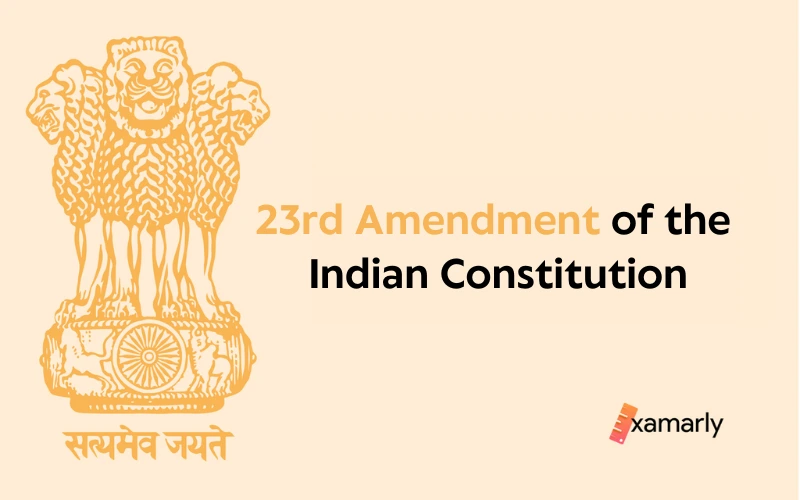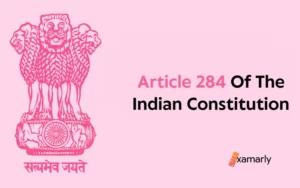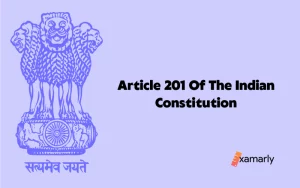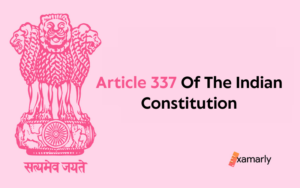This article brings into discussion the 23rd Amendment of the Indian Constitution. Students preparing for the UPSC exam will find this article worth reading. This is covered under Indian Polity in the UPSC syllabus.
Let us dive right into this constitutional amendment.
The Scheduled Tribes in Nagaland were no longer guaranteed seats in the Lok Sabha and the State Legislative Assembly due to the 23rd Amendment of the Indian Constitution. This amendment also prohibited the Governor from appointing more than one Anglo-Indian to a State Legislative Assembly.
You will explore more information about the 23rd Amendment of the Indian Constitution in the coming sections.
- 23rd Amendment of the Indian Constitution: Explained
- Statement of Objects and Reasons
- Facts and Features
- Date enacted
- Important provisions
- Ratification
- Conclusion
- FAQs related to the 23rd Amendment of the Indian Constitution
- Articles 330 and 332 of the Indian Constitution were revised due to which amendment act?
- Which amendments are related to the 23rd Amendment of the Indian Constitution?
- In which year was Nagaland given the status of a State?
- Which bill held the Statement of Objects and Reasons for the 23rd Amendment of the Indian Constitution?
- Who introduced the bill in the Lok Sabha?
23rd Amendment of the Indian Constitution: Explained
The Constitution (Twenty-third Amendment) Act, 1969, is another name for the 23rd Amendment of the Indian Constitution.
With this, Nagaland’s Scheduled Tribes’ seats in the Lok Sabha and State Legislative Assembly were no longer reserved. Additionally, this amendment stated that the Governor could only propose one Anglo-Indian to each State Legislative Assembly.
Before the amendment, it was up to the state’s Governor to decide how many Anglo-Indians should be nominated to the State legislatures.
In addition, the amendment extended by another ten years the time of reservation of seats for Scheduled Castes and Scheduled Tribes. It also extended the representation of Anglo-Indians in the Lok Sabha and State Legislative Assemblies, all the way up to January 26, 1980.
Originally, Article 334 of the Constitution mandated that seat reservations end in 1960. However, the 8th Amendment extended this deadline to 1970.
This time frame was extended to 1980 with the 23rd Amendment of the Indian Constitution.
The 45th Amendment, 62nd Amendment, 79th Amendment, 95th Amendment, and 104th Amendment also extended this time period. These amendments increased the duration of the aforesaid reservation to the year 1990, 2000, 2010, 2020, and 2030 respectively.
Also Read: 22nd Amendment of the Indian Constitution
Statement of Objects and Reasons
The provisions of Article 334 of the Constitution deal with the representation of the Anglo-Indian community in the House of the People (Lok Sabha) and the State Legislative Assemblies by nomination.
The article also states that the reservation of seats for the Scheduled Castes and Scheduled Tribes expires twenty years after the Constitution’s founding.
Even though the Scheduled Castes and Scheduled Tribes have made considerable progress over the previous 20 years, the factors that the Constituent Assembly considered when it set provisions for the abovementioned reservation of seats and nomination of members still hold true.
Thus, it is recommended that the Scheduled Castes and Scheduled Tribes’ reservations be extended for an additional ten years. Additionally, Anglo-Indian representation via nomination is extended for another ten years.
In 1963, the nation of Nagaland was established. In this state, tribal people make up more than 90% of the population.
It would be unusual to tailor revision for reservation for SC and ST in states with Legislatures where these tribes predominate.
As a result, it is suggested that no reservations be made in Nagaland for the Scheduled Tribes, as demanded by the Nagaland government. Reservations could be made neither in the House of the People nor in the State Legislative Assembly.
Amendments to Article 330 and Article 332 of the Constitution are necessary to achieve this.
In accordance with Article 333 of the Indian Constitution, it is up to the Governor of a state to decide how many Anglo-Indians should be nominated for seats in the state legislative assemblies.
It is presently suggested to change that section such that it requires the Governor to appoint no more than one Anglo-Indian to every state legislature. This would limit the number of Anglo-Indians that may serve in any state legislature.
However, this change won’t affect how the Anglo-Indian community is represented in those bodies until the ongoing Legislative Assemblies are abolished.
Facts and Features
| Who put forth the 23rd Amendment of the Indian Constitution? | P. Govinda Menon, the Law Minister at the time, presented it. |
| When was it introduced? | The Lok Sabha first heard about this amendment on August 21, 1969. |
| The official name of the Amendment | The Constitution (Twenty-third Amendment) Act, 1969. |
| Which articles were amended under the 23rd Amendment of the Indian Constitution? | Articles 330, 332, 333, and 334 of the Constitution |
Date enacted
Panampilly Govinda Menon was serving as the Minister of Law then. He introduced the Constitution (Twenty-third Amendment) Bill, 1969 in the Lok Sabha on August 21, 1969.
Articles 330, 332, 333, and 334 of the Indian Constitution were all targeted for change by the bill. The bill was discussed in the Lok Sabha on December 8 and 9, 1969.
The Rajya Sabha reviewed it on December 16 and 17, 1969. Rajya Sabha approved it on December 17, 1969.
President V. V. Giri approved the proposal on January 23, 1970, after it had received State ratification.
Important provisions
Amendment of Articles 330 and 332– The scheduled tribes in Nagaland is no longer entitled to reservations in the Lok Sabha and the State Legislative Assembly, according to sections 2 and 3 of the act amending Articles 330 and 332 of the Constitution.
Amendment of Article 333– Section 4 of the modification to Article 333 of the Constitution provides that the Governor may designate no more than one member of the Anglo-Indian community to serve in any State Legislative Assembly.
There shall be no consequence on the representation of the Anglo-Indian community in the Legislative Assembly of any State that existed at the beginning of this act until such time as that Assembly is dissolved as a result of the application of the provisions of sub-section (1).
Amendment of Article 334– In this article, it is proposed that the words “thirty years” shall replace and be inserted in place of “twenty years”.
In accordance with Section 5 of the Constitution’s amendment to Article 334, the Anglo-Indian community by nomination will continue to be represented in the Lok Sabha and the State’s Legislative Assemblies for a further ten years.
Furthermore, it provides for the continuance of reservation for the Scheduled Castes and Scheduled Tribes for an additional 10 years.
Ratification
In compliance with the requirements of Article 368 of the Indian Constitution, the act was passed.
Moreover, it received the approval of more than 1/2 of the State legislatures, as needed by the second clause of the aforementioned article.
Kerala, Punjab, Assam, Nagaland, Madhya Pradesh, and other states’ legislatures are a few examples of those that ratified the modification. Bihar, Andhra Pradesh, Gujarat, Orissa, Jammu and Kashmir, Uttar Pradesh, and Haryana did not ratify the modification.
You Might Also Like: 24th Amendment of the Indian Constitution
Conclusion
Through this blog for UPSC preparation, you learnt that the 23rd Amendment of the Indian Constitution is a landmark legal amendment passed in India in 1969.
The amendment addresses the reservation of seats to scheduled castes and Scheduled tribes in the lower House of the Parliament and the State legislatures as well. The maximum number of Anglo-Indians allowed to serve in various organizations is stated.
The amendment also added ten more years to the period in which seats were reserved for people who belong to the Scheduled Castes and Scheduled Tribes.
FAQs related to the 23rd Amendment of the Indian Constitution
Articles 330 and 332 of the Indian Constitution were revised due to which amendment act?
The 23rd Amendment made the proposed changes in Articles 330 and 332 of the Indian Constitution. Due to these modifications, Nagaland gets no reservations in the Lok Sabha or the State Legislative Assembly.
Which amendments are related to the 23rd Amendment of the Indian Constitution?
The 8th, 45th, 62nd, 79th, and 95th Amendments of the Indian Constitution are related to the 23rd Amendment of the Indian Constitution.
In which year was Nagaland given the status of a State?
1969.
Which bill held the Statement of Objects and Reasons for the 23rd Amendment of the Indian Constitution?
The Constitution (Twenty-third Amendment) Bill, 1969.
Who introduced the bill in the Lok Sabha?
P. Govinda Menon.






